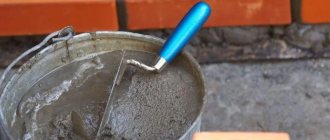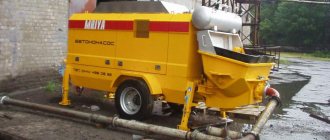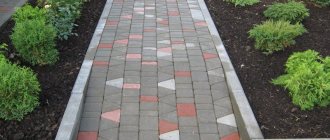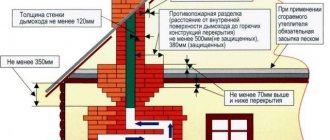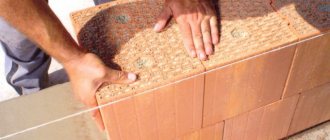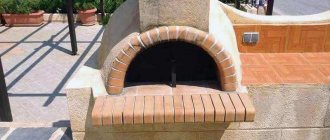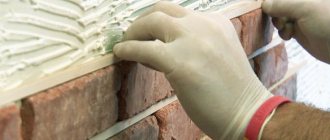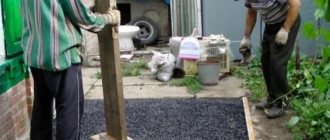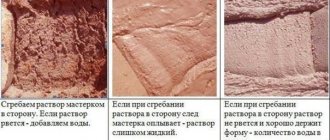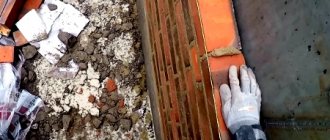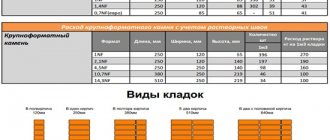Thermal insulating heat-saving masonry mortar
For laying single-layer block walls, it is recommended to use adhesive solutions. The use of glue allows you to lay walls with a joint thickness of only 2 mm.
But, the use of glue for filling joints when laying single-layer walls made of aerated concrete, gas silicate blocks, as well as ceramic, expanded clay concrete, wood concrete blocks, and blocks made of other materials, is only possible when using blocks with a height deviation of no more than +/- 1 mm.
(category 1 for deviation of geometric parameters).
Not all manufacturers produce such blocks. And blocks with height deviations of no more than +/- 3 mm are more affordable.
(category 2). These blocks must be placed in the wall on a mortar with a joint thickness of 8-12 mm.
The use of conventional cement-sand mortar for laying external single-layer walls made of blocks significantly reduces their heat-shielding properties. The thermal conductivity coefficient of masonry increases to 30% compared to masonry with glue (for D400-500 blocks). It's too much.
Therefore, for laying external single-layer walls made of blocks, heat-insulating lightweight warm mortars with a dry density of less than 1500 kg/m3 should be used.
Significant advantages of warm mortar for laying ceramic blocks
During construction, you must adhere to those components that are indicated in the approved project. In this case, a comparison with food products would be appropriate. A cake prepared with the addition of butter, vegetable fat, or margarine will differ in its taste. Likewise, a house made of ceramics using warm mortar will be better than the same structure using cement mortar. Advantages of using a warm solution:
- high-quality connection of blocks without the appearance of “cold bridges”;
- increase in energy efficiency (by 30% or more);
- high strength;
- long service life;
- environmental friendliness and health safety;
- cost-effectiveness associated with the use of thin-seam masonry technology;
- high level of moisture retention;
- affordable price.
Although warm mortar for laying ceramic blocks is higher in cost than conventional cement and sand, its use guarantees high quality of constructed buildings. For a specialist this will be immediately visible, but for the consumer it will appear during the operation of the building.
READ ON THE TOPIC: Size of ceramic bricks and its characteristics
How to properly prepare thermal insulating masonry mortar
Warm lightweight masonry mortar is prepared using cement and lightweight aggregates - expanded clay or perlite sand, polystyrene foam granules.
Perlite is a rock of volcanic origin, hardened stone foam.
Adding lime to the mixture increases the plasticity of the solution.
It is convenient to prepare a warm, light masonry mortar from a dry masonry mixture.
On the construction market you can find ready-made dry mixtures of various compositions for preparing thermal insulating masonry mortar.
For example, a dry masonry mixture from one of the manufacturers based on cement, mineral filler - perlite and plasticizing additives has the following characteristics:
Name of the mixture: Dry masonry heat-insulating mixture. Compressive strength grade: M50. Thermal conductivity coefficient (W/m°C) - 0.21 / 0,93
Average density (kg/m3) - 1000
/ 1800
Output of solution from 20 kg. dry mixture - 34 l. Frost resistance - 25 cycles Shelf life - 12 months.
(The value for ordinary cement-sand mortar is indicated through a slash (/).
From the given data it is clear that more than 4 times more heat is lost through a seam made from a regular mortar than through a seam made from a heat-insulating mortar.
The method for preparing the solution is usually indicated on the packaging of the finished dry mixture. Exact implementation of the recommendations indicated on the packaging guarantees a solution with good plasticity and adhesion to masonry blocks.
When choosing a ready-made dry mixture, you should be guided not only by the price, but also take into account how much of the finished solution is obtained from one package.
For example, a 25-kilogram bag of dry mixture from one manufacturer produces 40 liters of ready-made solution, but a package of the same weight from another manufacturer will allow you to prepare only 18 liters of solution.
The amount of ready-made solution that can be prepared from the dry mixture must be indicated on the product packaging.
When purchasing a dry mixture, also pay attention to the thermal conductivity coefficient - the lower, the better.
Effective mixture for hot ceramics
In order to minimize heat loss penetrating through the seams when laying porous blocks, it is recommended to use not the usual solution of cement and sand, but special mixtures containing material with low thermal conductivity (perlite, vermiculite, pumice) and all kinds of plasticizers. The creation of a productive warm solution for laying ceramic blocks is carried out on the basis of development and practical testing, assessments of productivity, efficiency and compliance with the required indicators. Developers and technologists from many industrial enterprises producing technological mixtures are working on this.
Composition of lightweight cement mortar for laying blocks
To independently prepare warm, light masonry mortar brand M50, the table provides several recipes:
| Brand according to solution density, kg/m3 | Component ratio by weight | Materials |
| D1400 - 1500 | 1 : 0,5 : 4 | Cement: lime: expanded clay sand |
| D1200 - 1300 | 1 : 2,8 : 1 : 0,15 | Cement: sand from aerated concrete waste: lime: perlite sand |
| D1100 | 1 : 0,6 : 0,24 | Cement: quartz sand: perlite sand |
note
— the dosage of binders, fillers and additives should be made
by weight.
To improve the plasticity of the solution, hydrophobic or air-entraining additives are used in amounts up to 0.2% by weight of cement.
As the density of the solution decreases, the thermal conductivity coefficient also decreases.
When preparing the solution, 50-70% water, aggregate and cement are first loaded into the container, which are mixed for 1-2 minutes. After this, the composition is mixed with the rest of the water and additives.
Perlite grains are very fragile. When mixed for a long time in a concrete mixer, they are crushed, which reduces the heat-saving properties of the solution. Do not mix the solution with perlite longer than necessary.
When laying, the block is lowered onto the mortar from above, avoiding horizontal movement of more than 5 mm. Excess solution that is squeezed out is removed immediately, preventing it from setting. Blocks can be straightened by rocking or tamping with a tool to prevent mechanical damage.
It is recommended to moisten the block surfaces with water before applying the solution.
During the masonry work, it is necessary to provide protection for the masonry joints from too rapid drying and atmospheric influences - sun, rain, frost.
Special composition
Each manufacturer produces a mixture based on its own standards, developed by specialists. All mixtures are sold in dry form. A packaging unit (a bag weighing 20-35 kg) contains the required amount of mixture, which will guarantee the highest quality of the finished solution. 35 kg of dry mixture yields 31 kg of mortar for laying ceramics. As in sand-cement mortar, the primary binding component in it is Portland cement.
Increased plasticity, frost resistance, water resistance, and acceleration of hardening are achieved through the inclusion of additives with a polymer base. Porous fillers reduce thermal conductivity. Most clients buy the finished version of dry mix from various manufacturers, guided by reviews of other consumers and recommendations of experienced builders. Some consumers make the mixture themselves from the necessary ingredients. To do this, ingredients are purchased in the required quantities and mixed together.
Warm mortar for ceramic blocks Thermal insulating masonry mixtures Warm adhesive for ceramic tiles Laying bricks with warm cement mortar
Consumption of mortar for laying blocks
For laying 1 m2 of a single-layer wall
from smooth blocks 30 - 40 cm thick. Approximately
20 - 30 liters of mortar are needed
with a joint thickness of 10-12 mm.
For buildings with a height of 1-2 floors, it is possible to further reduce heat loss through the mortar joint, as well as reduce its consumption.
To do this, when laying the mortar, apply it in two stripes along the outer and inner surfaces of the wall, leaving in the middle of the wall an air gap in the seam 1/3 - 1/4 wide of the width of the block. This measure reduces the thermal conductivity of the seam, but at the same time reduces the load-bearing capacity of the masonry - therefore it is used only for buildings of small height.
A smaller amount of mortar will be needed if you use blocks with a tongue-and-groove connection of vertical joints for masonry. In this case, vertical seams are not filled with mortar.
The use of warm, lightweight masonry mortar can significantly improve the thermal conductivity of the wall compared to conventional mortar, but not so much as to be on par with an adhesive joint. In addition, the consumption of glue is several times less than that of a light solution, and the price of ready-made dry mixtures of glue and solution is almost the same.
Warm light masonry mortar is not recommended for laying walls that can be intensively moistened - foundation, basement, basement.
For information on laying gas silicate and aerated concrete blocks with glue, read the article Laying gas silicate and aerated concrete blocks with glue.
Next article:
Interior finishing of aerated concrete walls
Previous article:
Laying walls from aerated concrete blocks - video tutorial
⇆
More articles on this topic
- Bituminous shingles. Installation and laying of soft roofing
- How to properly insulate an attic
- Thermal block, thermal wall, flint granite, polyblock - three-layer wall block
- Prefabricated dry floor screed from sheets of gypsum fiber board, chipboard, OSB, plywood
- Facade paint for exterior use
- House with monolithic walls made of large-porous expanded clay concrete
- Minimum thickness of a wall made of bricks or blocks
- Snow load map
As is known, the Russian Federation has adopted increased standards of thermal characteristics for enclosing wall structures. So, at the latitude of Moscow, the thermal resistance of the wall R should be at least 3.15 K/W. It is clear that to achieve such high levels of thermal protection, it is necessary to use materials with reduced density and a high coefficient of thermal resistance. Such materials include cellular concrete products (foam and aerated concrete, gas silicates, expanded polystyrene concrete), as well as large-format ceramic blocks with or without mineral wool filler. The thermal conductivity coefficient of such materials is usually at the level of 0.06 - 0.08 W/m K for expanded polystyrene concrete, 0.12 - 0.16 W/m K for gas silicates and 0.16 - 0.20 W/m K for foam concrete and large-format ceramic blocks. When laying walls made of these materials using conventional cement-sand mortars with a density of 1700...1800 kg/m3 and an average thermal conductivity coefficient of 0.7-0.9 W/m K, additional heat losses through these “cold bridges” are inevitable, which worsens the thermal characteristics of the wall structure. Research conducted at the Institute of Building Physics showed that with an average thickness of a masonry joint of only 10-12 mm, made from ordinary masonry mortar, the overall thermal resistance of the entire structure decreases by 20%. In general, it can be assumed that with an increase in the average density of the solution compared to the density of wall materials, for every 100 kg/m3, heat loss increases by 1%. There are only 2 ways out of this situation: either use thin adhesive joints, or in cases where this is impossible due to the geometry of the materials used, use special heat-insulating masonry mixtures, or the so-called. "WARM SOLUTIONS". The problem of using lightweight warm solutions is relevant not only when performing various types of plastering work in places where the use of an additional layer of insulation is for some reason difficult or impossible, but also when creating heat-insulating screeds. In this case, the average density of the hardened layer should be comparable to the density of highly porous wall materials, that is, it would range from 600...800 kg/m3 in the case of plaster coatings to 1100-1200 kg/m3 for masonry and warm installation mortars. High-quality warm mortars must have appropriate strength, durability and adhesion to the wall material, and the mortar mixture must have standardized values of mobility, water-holding capacity, the necessary viability, as well as plastic strength sufficient to bear the load from the overlying parts of the building during the initial period of hardening of the mixture in the masonry. In addition, the formulation of warm solutions must take into account the increased water-absorbing characteristics of wall materials and provide for the presence of additives that prevent leaching (efflorescence) during operation. As you know, the strength of masonry depends more on the strength of the wall material than on the brand of mortar. Thus, when the strength of the mortar decreases by one grade, the strength of the masonry decreases by only 10...15%. The minimum grades of mortar for masonry in various conditions should be from M10 to M50. In addition, warm mortars are intended primarily for laying low-rise buildings made of highly porous wall materials with a strength of 3...5 MPa. Based on this, the strength of warm mortars should be in the range from 1 to 5 MPa (grades M10...M50). Along with ensuring the required strength of the mortar, one of the important mechanical characteristics of the mortar mixture is plastic strength, which ensures the bearing capacity and incompressibility of the mortar mixture layer during masonry work. As has been established by special studies, the most effective way to obtain warm solutions is the simultaneous use of porous aggregates with a rational granulometric composition and the simultaneous porosization of cement paste when obtaining a working solution at the work site, for which it is necessary to introduce effective porousizers into the dry mixture formulation, which allows saturating the final solution by 30% with air bubbles. In this case, no special equipment is required; it is enough to use an ordinary turbulent mixer when mixing the mixture. When porous aggregates and air-entraining additives are used together in the preparation of warm solutions, the properties of the solutions change significantly depending on the phase and granulometric composition, the nature of the surface of the aggregate grains and the structure of the grain porosity, the strength and deformability of the grains, as well as on the relationship between the pore structure of the cement stone formed during air entrainment and various fillers. As a result of two years of research, CJSC “Company “POBEDIT” has developed and put into mass production a whole group of warm solutions for various purposes:
1. WARM MASONRY MORTAR “WIN TM-36” TECHNICAL CHARACTERISTICS: For dry mix : Packaging - 22 kg; Light filler – perlite sand; Bulk density of the dry mixture – 1100 kg/m3; For the working solution: Water consumption for preparing the solution is 6.2–6.6 liters per 22 kg bag; Viability – at least 2 hours; Air entrainment – up to 30%; Application thickness per 1 pass – 4-30 mm; Application temperature: in the summer version - from +5 to +30 °C, in the winter version - from -10 to +5 °C. For the final layer: Color - light gray; Compressive strength – up to M 75; The density of the hardened solution is 1150 kg m3; Frost resistance of hardened mortar F75; Thermal conductivity coefficient of the hardened solution (λ, W/m C) - 0.20; Adhesive strength – not less than 0.25 MPa. The main advantages of the mixture “POBEDIT TM-36”: •The mortar mixture has high plasticity. One of the most budget options for masonry work using “warm solutions”; •Various water-absorbing characteristics of wall materials are optimally taken into account; •Special additives prevent the formation of efflorescence; •The non-shrinking nature of the solution provides it with high crack resistance, which allows the composition to be applied in a thick layer.
2. WARM SCREED “WIN PENOPOL TM-30” TECHNICAL CHARACTERISTICS: For dry mixture: Packaging - 12 kg; Lightweight filler – fractionated foam glass; Average consumption is about 4 - 5 kg for every cm of thickness per 1 m² of surface. For the working solution: Water consumption for preparing the solution is 6.5–7.5 liters per bag; Viability – at least 2 hours; Application thickness per 1 pass – 5-30 mm; Application temperature: from +5 to +30 °C. For the final layer : Color - light gray; Compressive strength – up to M 80; Thermal conductivity coefficient of the finished layer (λ, W/m C) - 0.11; Adhesive strength – not less than 0.30 MPa. The main advantages of the warm screed “WIN PENOPOL TM-30”: •The mortar mixture has high plasticity. The composition is unique and has no analogues. Economical in price and consumption; •After complete drying, the applied layer has very low thermal conductivity; •Due to its non-shrink properties, the composition can be applied in a thick layer without fear of cracks.
3. WARM GLUE FOR POLYSTYRENE CONCRETE BLOCKS “WILL WIN-EGIDA POLYSTYRENE G-32 T” TECHNICAL CHARACTERISTICS: For dry mix: Packaging - 18 kg; Light aggregate – fractionated perlite sand; Average consumption is from 8 to 10 kg per 1 m3 of stacked blocks. For the working solution: Water consumption for preparing the solution is 11 - 12 liters per 18 kg bag; Viability – up to 2 hours; Correction time – up to 15 minutes; The thickness of the applied layer is from 2.0 to 15.0 mm. Application temperature: from +5 to +30 °C. For the final layer: Time to achieve tensile strength equal to that of a Unicon type block (M15) – 24 hours; Thermal conductivity coefficient of the hardened solution (λ, W/mS) - 0.14; Compressive strength – up to M 20; Adhesive strength – not less than 0.3 MPa.
The main advantages of the adhesive “POBEDIT-EGIDA POLYSTYRENE G-32 T”: •HARDENED SOLUTION HAS VERY LOW – ABOUT 0.14 W/m C – thermal conductivity coefficient. The use of this glue completely eliminates the appearance of “cold bridges”. •The mortar mixture has high plasticity and thixotropy. •The adhesive provides high fixing ability within 20-24 hours after laying the blocks. •Additional advantages of this glue include the ability to carry out masonry with minimal (almost up to 2 mm) thickness of the adhesive joint, which significantly affects the increase in thermal protection of the buildings being constructed. The glue is characterized by accelerated strength gain.
In addition to the presented masonry and installation mortars, we have developed and mass-produced 3 types of warm plasters. These are heat-insulating plaster “WIN FOAMGLASS TM-30” (light filler – granulated foam glass), heat-insulating plaster “WIN PERLIT TM-30” (light filler – fractionated perlite sand) and sanitizing warm plaster “WIN TM-30 SANITATING” (light filler – combination perlite sand and foam glass, containing a blowing agent). At the moment, tests of the warm plaster “POBEDIT-EGIDA XI-S 42 L”, which is specially designed to protect YTONG gas silicate blocks, are being completed in Germany. The use of warm solutions will significantly reduce heat loss through building envelopes, reduce the weight of structures, and reduce material consumption
How to make cement mortar with your own hands
When constructing any structure or object, it is necessary to use cement mortar. You can prepare it yourself. To do this, you need to know how to knead it correctly. How to do it?
Table of cement composition.
What will you need to prepare?
Cement, sand, crushed stone - materials for preparing cement composition.
Before preparing the cement composition for construction work, it is necessary to prepare the following tools and materials:
- bucket;
- container for mixing components;
- cement;
- sand;
- crushed stone;
- shovel;
- water;
- plasticizers and graphite (necessary in some cases).
Return to contents
How to prepare a mixture for brickwork?
It must be said right away that the preparation of cement compositions is carried out according to different recipes. It all depends on what purpose you need the mixture for. So, if you decide to make brickwork, then you need to prepare the simplest cement mortar. You can do it as follows. First, take the container; it must be clean, without any contamination. 1 part of grade 200 cement is poured into it. Then sand is gradually introduced into this component.
Table of cement consumption for bricklaying.
Its quantity should be 3 parts. After thorough mixing, 0.5 parts of water are added. You can pour it in immediately. Having done this, you need to mix everything thoroughly. This is done with a shovel. If you want to speed up the process, then use a construction mixer, but you should not turn it on at too high a speed.
In this way, a cement-based composition for brickwork is prepared. Having done everything correctly, you will get a homogeneous consistency. With its help, you can successfully carry out construction work, which will take place quickly and without unnecessary hassle.
Return to contents
How to prepare a mixture for facing masonry?
Now we should consider how to properly prepare a cement-based mortar for facing masonry. Here you will need to make a composition that will set quickly and at the same time will not crumble when opening the seams. It should be made on the basis of cement grade 200. For 1 part of this component you will need to take 3.5 parts of sand. There is no need to add crushed stone here, otherwise the cladding will have an uneven surface. If you want to give it expressiveness, it is recommended to add a small amount of graphite to the composition. It will make it darker. It will look great with a light facing brick.
If you use the mortar for cladding in winter, add table salt to it. The ratio should be as follows: 1 kg of salt per 1 bag of cement.
Return to contents
Preparation of the solution
The mixture is prepared by adding the specified amount of ordinary, preferably tap, water to the composition at the construction site. Spring and well water may contain various minerals that will cause adverse reactions. Although the solution is called warm, this does not mean that it needs to be diluted with hot water. Mixing is carried out in a concrete mixer. It is not recommended to stir the mixture for a long time, since perlite turns into granular fluff when vigorously whipped. Therefore, when a homogeneous mass is obtained, the mixing process is interrupted. Warm mortar for laying ceramic blocks is used for ceramic blocks, as well as in the construction of houses made of aerated concrete and cellular foam concrete.
Cement mortar in winter
Cement mortars can be used at any time of the year, but it is necessary to take into account weather conditions and air humidity. The cement mortar freezes in winter, at subzero temperatures, and physical phenomena begin to occur in it, which subsequently affect its strength and structure.
When the mixture freezes, the water in it turns into ice and does not combine with binders. To avoid this problem, when purchasing, you need to clarify whether the composition contains antifreeze additives and how best to use it. Preparing cement mortar in winter means mixing components with antifreeze additives that will accumulate strength in mild to moderate frosts. Additives are used for underground brickwork, regularly shaped stones or rubble. When using cement mortar above ground, sodium nitrite or potash is added in winter.
Purchased mortar mixtures are used at air temperatures down to -10 degrees; the composition itself with additives should not have a temperature below 5°C. The cement mortar should not be frozen and subsequently warmed with hot water, and you must also ensure that the winter composition goes into use immediately and does not have time to set.
There are also other ways to protect cement and its mortar from low temperatures in winter:
1) Masonry is made by freezing, using a warm composition;
2) The masonry is heated artificially, using air heating units, air heaters and other heating devices;
3) You can also build a temporary shelter and warm it with heat guns or cover it with PVC film and insulation.
March 4, 2013
| Related articles: | |
| Cement based self-leveling floor Floor screed can have different compositions and functional features, suitable for rooms with different functions. Cement based self-leveling floor... | |
| Cement mixture for floor screed A flat and smooth floor can only be achieved if the materials for it are selected correctly and the screed has the required density... | |
| Features of the use of cement bonded particle board DSP or cement-bonded particle board is made from Portland cement, chemical additives and wood shavings. They have been used for over forty years in various... | |
betonocement.ru
how to cook with your own hands, instructions, photos, price and video tutorials
The use of brickwork in construction still continues to be relevant. Despite the labor-intensive nature of this process, the construction of walls made of brick building materials is not going to stop.
Construction work is carried out both in summer and winter. And it is clear that in frosty weather, the cement mortar used for masonry will lose its binding properties. To continue work, builders use tricks that allow them to restore the properties of the cement mortar.
Construction does not stop even in winter
Cement-lime mixture
The solution is easy to make!
Cooking method
In normal summer conditions, at above-zero temperatures, a standard mixture is used, which is prepared with your own hands, according to time-tested technology (see also the article Composition of mortar for bricklaying is the key to success in construction).
To create it you need:
- Lime.
- Sand.
- Cement.
The first step is to create the so-called lime paste, which is made by mixing lime and water. After this, the resulting gruel is filtered through a fine sieve.
In parallel with this, a mixture of sand and cement is mixed separately. Lime paste and some more water are already poured into it. It is precisely this mixture that is used to fasten the brick structure. However, in winter everything is different.
Effect of frost
Construction workers work in winter conditions
What happens to the solution in the frosty season? The thing is that the slurry that holds building bricks together contains a considerable amount of water, which in a liquid aggregate state perfectly performs its binding function.
But as soon as the temperature passes zero, the water turns into ice crystals, which destroy the entire structure of the lime-cement mortar.
Based on this state of affairs, several methods have been invented to make it possible to carry out masonry during the frosty winter period. One of them is the preparation of a special winter mixture.
Mixture for winter conditions
Preparation
Photo of calcium chloride
Winter mortar for bricklaying differs from a similar one for the summer period only in some additives. These additives allow the water contained in the binding slurry to return to a liquid aggregate state and restore the binding properties of the slurry.
Now, in a few words, we will tell you how to prepare this mixture. Special chemicals are added to the finished mixture (
